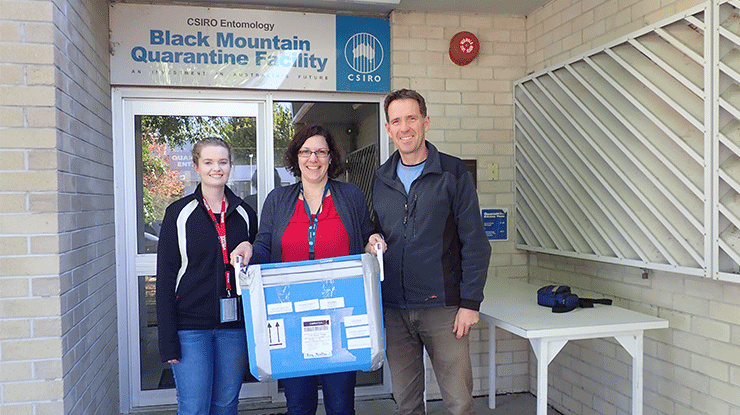 CSIRO researchers Elissa Rice, Dr Valerie Caron and Patrick Gleeson with a shipment of dung beetles from Morocco, via CSIRO in France. Source: CSIRO
CSIRO researchers Elissa Rice, Dr Valerie Caron and Patrick Gleeson with a shipment of dung beetles from Morocco, via CSIRO in France. Source: CSIRO
New dung beetles rolling through
The team behind the Dung Beetle Ecosystem Engineers (DBEE) project are working away as busily as their insect partners to mass‑rear their first imported species in preparation for release.
After meeting some of the toughest importation requirements in the world, CSIRO and Charles Sturt, University researchers are breeding up a Moroccan strain of the dung beetle, Onthophagus vacca.
The goal is for the spring‑active beetle to help fill seasonal and geographical gaps in current dung beetle activity in southern Australia, a climate similar to its home range.
Dr Valerie Caron, who leads CSIRO’s international biocontrol team in Canberra, said importing any live animal into Australia takes time and paperwork.
“The beetles were collected in Morocco before being formally identified and cleaned at CSIRO’s laboratory in France,” Valerie said.
“After receiving the import permit we brought about 2,000 beetles into our quarantine facility in Canberra for rearing.”
Despite the challenges of rearing in quarantine (only sterilised eggs can be released from quarantine and the sterilisation process can reduce the fitness of subsequent adults) the team was able to deliver the first batch of O. vacca beetles to Charles Sturt in May.
Charles Sturt will manage the mass‑rearing of tens of thousands of beetles at various rearing facilities, before transferring them to on‑farm nurseries for further assessment, before releasing them at strategic sites over the next four years.
CSIRO’s French team are now assessing three more Moroccan species, with the aim of importing and rearing the two species which are most efficient at burying dung.
Monitoring
DBEE technical research coordinator, Charles Sturt and senior research fellow Dr Russ Barrow have been busy on another component of the project: monitoring the introduced dung beetle species currently distributed in southern Australia across at least 120 sites.
Russ is one of several team members working to establish the sites and train project partners in monitoring protocols.
“Twenty‑three species have established in Australia since CSIRO began releasing them in the 1960s,” Russ said.
“We’re looking to gather data on current dung beetle species, location and abundance, to identify any gaps we can overcome through breeding, trapping and redistribution.”
Miniature livestock
DBEE program manager and agricultural consultant Paul Meibusch is looking forward to the day when livestock producers manage their dung beetles just like they do their sheep and cattle.
“Dung beetles have so many benefits for producers: they improve soil health and water infiltration, making farms more resilient and quicker to recover in times of drought; they retain nutrients on‑farm, preventing run‑off into waterways and reducing fertiliser requirements; they prevent the build‑up of fly and worm eggs; and they reduce greenhouse gas emissions and sequester carbon in the soil,” Paul said.
“I’d like producers to see dung beetles as miniature livestock and manage their systems carefully – including being aware of what they’re drenching animals with and when – to ensure beetles are protected and encouraged.”
A key outcome of the project will be a website containing regionally specific dung beetle management advice.
The project is supported by MLA through funding from the Australian Government’s Rural Research and Development for Profit program.



